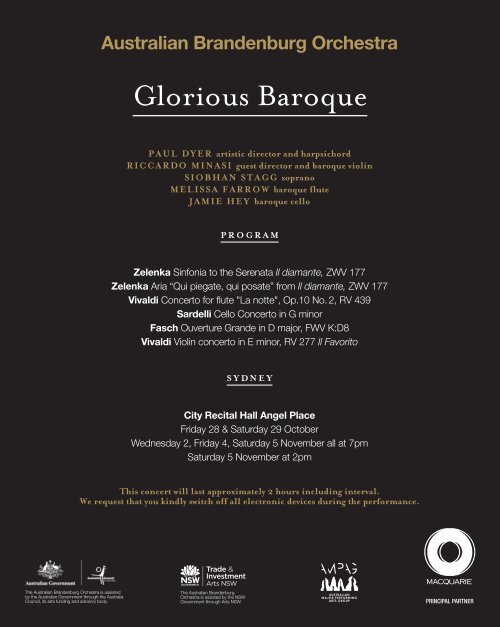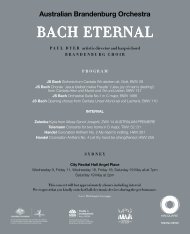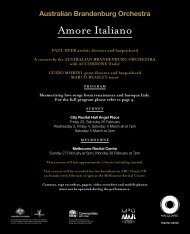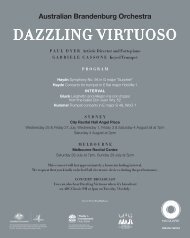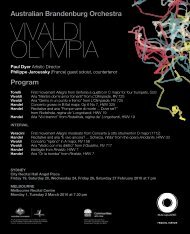download PDF program - Australian Brandenburg Orchestra
download PDF program - Australian Brandenburg Orchestra
download PDF program - Australian Brandenburg Orchestra
You also want an ePaper? Increase the reach of your titles
YUMPU automatically turns print PDFs into web optimized ePapers that Google loves.
<strong>Australian</strong> <strong>Brandenburg</strong> <strong>Orchestra</strong><br />
Glorious Baroque<br />
Paul Dyer artistic director and harpsichord<br />
RICCARDO MINASI guest director and baroque violin<br />
SIOBHAN STAGG soprano<br />
MELISSA FARROW baroque flute<br />
JAMIE HEY baroque cello<br />
<strong>program</strong><br />
Zelenka Sinfonia to the Serenata Il diamante, ZWV 177<br />
Zelenka Aria “Qui piegate, qui posate” from Il diamante, ZWV 177<br />
Vivaldi Concerto for flute "La notte", Op. 10 No. 2, RV 439<br />
Sardelli Cello Concerto in G minor<br />
Fasch Ouverture Grande in D major, FWV K:D8<br />
Vivaldi Violin concerto in E minor, RV 277 Il Favorito<br />
SYDNEY<br />
City Recital Hall Angel Place<br />
Friday 28 & Saturday 29 October<br />
Wednesday 2, Friday 4, Saturday 5 November all at 7pm<br />
Saturday 5 November at 2pm<br />
This concert will last approximately 2 hours including interval.<br />
We request that you kindly switch off all electronic devices during the performance.<br />
The <strong>Australian</strong> <strong>Brandenburg</strong> <strong>Orchestra</strong> is assisted<br />
by the <strong>Australian</strong> Government through the Australia<br />
Council, its arts funding and advisory body.<br />
The <strong>Australian</strong> <strong>Brandenburg</strong><br />
<strong>Orchestra</strong> is assisted by the NSW<br />
Government through Arts NSW.<br />
PRINCIPAL PARTNER
Glorious Baroque<br />
“and all who were present were even more delighted with the King’s pleasant<br />
manners than with the loveliness of the scene and the magnificence of the feasts …<br />
The court was the most brilliant in Europe, full of magnificence,<br />
stateliness and pleasure.”<br />
Baron Carl Ludwig von Pöllnitz, 1739<br />
In the first half of the eighteenth century, if you wanted to hear the best orchestra in Europe play works<br />
by the finest composers, and marvel at the virtuosity of the best opera singers conducted by the best<br />
opera composer, the place to go was Dresden. Known as “Florence on the Elbe” because of its beautiful<br />
buildings and art treasures, it was the seat of the Electors of Saxony, absolute monarchs of immense<br />
power and wealth. Under the rule of Elector Friedrich Augustus I and his son, Friedrich Augustus II,<br />
Dresden became one of the supreme cultural centres in Europe. The ability to impress one’s subjects,<br />
other rulers and potential enemies with magnificent displays underscored the power of an absolute<br />
monarch, and there was constant entertainment for visiting dignitaries, according to Baron von Pöllnitz,<br />
with “plays, masquerades, balls, banquets, tilting at the ring, sleigh-races, tourings, hunting parties ...<br />
The plays and the masquerades open to anyone who was well dressed …”<br />
Augustus I was known as “The Strong” because of his immense physical strength: he was able to break<br />
horseshoes with his bare hands and excelled at the dubious but popular Germanic blood sport of “fox<br />
tossing”. However, he and his family had a love and appreciation for art and music, for its own sake.<br />
They had a high regard for cultures imported from France and Italy, and because the Electors of Saxony<br />
were Kings of Poland in this period the Polish influence was also strong.<br />
The Dresden court orchestra was without rival for the first half of the eighteenth century, and all the<br />
major composers of the time wanted their music played there. The orchestra was truly international,<br />
with players from France, Italy and The Netherlands performing under the direction of Vivaldi’s student<br />
and friend Johann Georg Pisendel. Under Pisendel’s leadership the Dresden orchestra became the<br />
major promoter of Vivaldi’s music outside Italy, and this was to have a far-reaching influence on German<br />
composers such as Johann Fasch and JS Bach, who often visited Dresden.<br />
Many of the finest instrumentalists in Europe played in the orchestra, including for a time Johann<br />
Joachim Quantz (later flute teacher to King Frederick the Great of Prussia and author of an important<br />
treatise on playing the flute). In 1716 he marvelled at the orchestra’s unique “French smoothness of<br />
performance” and that it “achieved a finesse of performance which I have never heard bettered in all my<br />
travels.” Playing continuo in this orchestra of virtuosos were the great lutenist Silvius Leopold Weiss and<br />
composer and music theorist Jan Dismas Zelenka.<br />
10<br />
Jan Dismas Zelenka (1679-1745)<br />
Zelenka was described by a contemporary as the “perfect Virtuoso”, whose music gives a “foretaste<br />
of heavenly pleasure”, but after his death his works were virtually forgotten until the 1950s.<br />
Zelenka was one of a family of talented musicians who came from a small village south of Prague, then<br />
part of Bohemia (now the Czech Republic), an area renowned throughout Europe for the high calibre<br />
of the musicians it produced. He was twenty nine when he was lucky enough to secure the plum job
of double bass player in the Dresden court orchestra, in about 1710, and he remained employed by<br />
the Saxon court for the next thirty five years, the rest of his life. Zelenka and Pisendel travelled to Italy<br />
in 1716 and 1717 as part of the entourage of Prince Friedrich Augustus, the Elector’s son, who was<br />
on the look-out for Italian opera singers to sing in the court chapel and to form an opera company in<br />
Dresden. The group visited Naples and spent nine months in Venice, where Pisendel became firm friends<br />
with Vivaldi. It was this connection which began the almost cultish desire for Vivaldi’s music in Dresden.<br />
Around this time Zelenka also travelled to Vienna, where he studied with the renowned music theorist<br />
Fux, whose analytical exercises Mozart worked on fifty years later.<br />
In some ways Zelenka, a devout Roman Catholic, was in the right place at the right time as his arrival<br />
coincided with the court increasingly turning to Catholicism. Although the Saxon population were<br />
staunchly Lutheran, the Elector had converted to Catholicism in order to be eligible to be elected King<br />
of Poland by the Polish nobility. The new Catholic court chapel (the first Catholic church in Dresden)<br />
had only just been completed in 1708, and Zelenka was one of four composers who were kept<br />
busy constantly composing and directing music for the royal chapel. A strict hierarchy applied: the<br />
Kapellmeister (music director) Heinichen provided music for the most important religious feasts and<br />
royal occasions, with Zelenka providing music for occasions which were next in importance. His duties<br />
became more onerous in the 1720s when Heinichen became ill. When Heinichen died in 1729 Zelenka<br />
expected to succeed him, but although he acted in the job for the next five years he was bitterly<br />
disappointed when Johann Adolf Hasse was appointed instead.<br />
Sinfonia to the Serenata Il diamante ZWV 177<br />
Allegro – Adagio – Menuetto<br />
The serenata was a small scale Italian vocal composition popular with European royal courts from the<br />
middle of the seventeenth century until the middle of the eighteenth century. After the highly political<br />
marriage of the Electoral prince to the Habsburg princess Maria Josepha in 1719, serenatas were often<br />
performed in Dresden, probably because they were a regular part of the court entertainment in the<br />
princess’s native Vienna and because of Prince Friedrich Augustus’ fondness for Italian culture.<br />
A serenata was for several singers (but no chorus) and orchestra, and typically celebrated a particular<br />
occasion such as a birthday or military victory. The text was usually by a local poet and related directly<br />
to the event being celebrated, often in a strongly moralising way. It had the bare bones of a plot, and<br />
allegorical or mythological characters, but it was mostly little more than an elegant conversation aimed at<br />
flattering its subject. Singers were costumed, as in an opera, but there was minimal or no staging. There<br />
was usually an ornately painted scenic backdrop, and serenatas were often part of lavish entertainments<br />
including fireworks, banquets, and pageants. They were nearly always performed at court for invited<br />
guests only and often in the open air (the word serenata comes from the Italian sereno, meaning clear<br />
sky). This taxed the inventiveness of those responsible for mounting the performance: in Dresden in 1719 a<br />
serenata by Heinichen was performed on a boat on the river Elbe, with the court watching from the bank.<br />
Il diamante was composed in 1737 to celebrate the wedding of a Polish prince to the sister-in-law of<br />
one of the most powerful men in the Saxon court, Privy Councillor Count Alexander Sulkowsky, and was<br />
performed during the wedding banquet held at Sulkowsky’s palace. The names of the bride and groom,<br />
details of the military exploits of the groom’s ancestors, and a political statement emphasising<br />
the significance of the union between the two countries are all contained in the libretto. 11
Glorious Baroque<br />
The serenata opens with the god of earth offering a magnificent jewel (Il diamante) more lustrous than<br />
pearls and so bright that the stars envy it, in honour of a wedding on the banks of the Elbe (that is, in<br />
Dresden). The jewel is to be taken there by Hymen, goddess of marriage, as a pledge of fidelity and an<br />
omen of happy married life. The performance of the serenata was probably a surprise planned by the<br />
Electress, who gave the bride a jewel as a wedding gift.<br />
Composing the music for such a prestigious occasion would usually have fallen to Hasse as<br />
Kapellmeister, but he had been away in Vienna and on his return was busy preparing for the<br />
performance of his next opera. As this was a rare opportunity for Zelenka to write something so<br />
prestigious, he put everything he had into it. Although court reports of the wedding did not mention<br />
Zelenka by name, they praised the “...superb Concert performed by Kapellmeisters Hass[e] and Ristori,<br />
during which the entire Royal Kapelle and the Italian Virtuosi could be heard…”<br />
What to listen for<br />
A sinfonia was a short instrumental piece in three movements (fast-slow-fast) which functioned as an<br />
overture to Italian opera in this period and was the forerunner to the Classical symphony. Here the first<br />
movement, made up of three extended sections, is by far the longest and grandest, overshadowing the<br />
two short dance movements which follow. Zelenka made good use of the considerable forces of the<br />
superb court orchestra at his disposal, and the instrumentation is particularly rich and weighty, reflecting<br />
the importance of the occasion. The virtuoso players would have relished the rushing scales, chains of<br />
syncopated notes, fierce ascending scale segments, and other embellishments which were trademarks<br />
of Zelenka’s compositions.<br />
Aria "Qui piegate, qui posate" from Il diamante<br />
This aria for Venus, the goddess of love, comes at the very end of the serenata, and describes the<br />
changing nature of a love relationship, with alternate quarrels and reconciliations. The aria was added at<br />
the last minute, possibly for Faustina Bordoni, Hasse’s wife and the most celebrated female singer of the<br />
age. The focus of Zelenka’s career at Dresden was on producing sacred works, and he had almost no<br />
experience in writing theatrical compositions in the Italian style. Yet although this style of aria was foreign<br />
to him he managed to give Venus music that is both tender and passionate, as befits the goddess of<br />
physical love.<br />
What to listen for<br />
Because singers in serenatas stood still and read from the music while they sang, the music composed<br />
for them could be much more complex than for a fully staged work. This aria calls for a very high level of<br />
technical ability, with the soprano required to sing strings of trills and fast repeated notes, ornamentation<br />
which would have been the very fashionable in the 1730s. The singer’s part is matched in virtuosity<br />
by that of the flute. Its frequent short fluttering phrases resemble the beating of the wings of the dove<br />
referred to in the text. The turtledove was an emblem of devoted love.<br />
12<br />
Qui piegate, qui posate<br />
Mie colombe, i vanni erranti.<br />
E alternando e morsi e baci,<br />
Dolci sdegni e dolci paci<br />
Insegnate alla coppia.<br />
Qui piegate etc<br />
Here fold your wings and rest,<br />
My doves, from wandering.<br />
And with alternating bites and kisses,<br />
Sweet quarrels and sweet peace<br />
Teach the couple.
Glorious Baroque<br />
Antonio Vivaldi (1678–1741)<br />
Concerto for flute "La notte", Op. 10 No. 2, RV 439<br />
Largo<br />
Presto – Fantasmi (Ghosts)<br />
Largo<br />
Presto<br />
Largo - Il sonno (Sleep)<br />
Allegro<br />
Vivaldi gave three of his concertos the title “La notte”, or night. This one for solo flute, dating from<br />
1729, is an extended arrangement of the first, a chamber concerto (for a small number of instruments<br />
with no orchestra) written about ten years earlier. Along with his Four Seasons concertos it is the most<br />
<strong>program</strong>matic of Vivaldi’s music, that is, it is instrumental music which depicts a story or scene.<br />
In the Baroque period certain keys were associated with particular affects or emotions, and the key of<br />
this concerto, G minor, represented fear, agitation or revenge. It was a deliberate choice by Vivaldi for<br />
music which was intended to conjure up silence, mystery, and disturbing nocturnal visions. Nothing is<br />
known about why it was composed or for whom, however the virtuosic solo part pushed the boundaries<br />
of contemporary flute playing technique and indicates that Vivaldi must have intended it for an excellent<br />
flute player.<br />
What to listen for<br />
The concerto is atypical of Vivaldi’s usual compositional style in many respects. All of the “night”<br />
concertos have six movements (instead of the usual three), and the movements are characterised<br />
by sudden changes of tempo, bizarre twists and turns in harmonic direction, and unexpected shifts<br />
between major and minor. The first movement begins with the orchestra in unison in a dotted rhythm<br />
similar to a French overture which is full of foreboding. The second fast movement, titled “Ghosts” by<br />
Vivaldi, is marked by rushing ascending scales. A Largo (slow) movement provides a calm interlude of<br />
rest before another agitated Presto. In the second Largo, “Sleep” is represented by long, soft notes<br />
which seem barely to change in an unusually static harmony.<br />
Federico Maria Sardelli (b. 1963)<br />
Cello Concerto in G minor<br />
Andante molto molto<br />
Adagio<br />
Allegro ma poco<br />
14<br />
Federico Maria Sardelli is an Italian flautist, conductor and musicologist. In 1984 he founded the Baroque<br />
orchestra Modo Antiquo, with which he has appeared throughout Europe as both soloist and conductor.<br />
Since 2006 he has been principal guest conductor of the Turin Philharmonic <strong>Orchestra</strong> and has<br />
appeared as a guest conductor with many European symphony orchestras. He has made more
than forty recordings as soloist and conductor, and has twice been nominated for a Grammy Award.<br />
He has an expert knowledge of the music of Vivaldi, and conducted the first modern recordings and<br />
performances of a number of Vivaldi operas.<br />
Sardelli has written an authoritative book on Vivaldi’s flute and recorder compositions and has edited<br />
a number of critical editions of Vivaldi’s music. Since 2007 he has been responsible for correcting and<br />
updating the Ryom catalogue of Vivaldi compositions. This catalogue, begun in the 1970s by Danish<br />
scholar Peter Ryom, is an invaluable resource which lists all known Vivaldi compositions and identifies<br />
their source and publication details. It is represented by the prefix RV ( for Répertoire Vivaldien) after the<br />
title of the work.<br />
Sardelli is, like Vivaldi, a prolific composer across a range of genres, and this cello concerto is the first<br />
of his many compositions to be heard in Australia. It is also a world premiere, as this concerto was<br />
commissioned from Sardelli by Jamie Hey, the <strong>Australian</strong> <strong>Brandenburg</strong> <strong>Orchestra</strong>’s principal cellist, and<br />
has never previously been performed.<br />
What to listen for<br />
Sardelli has immersed himself in Vivaldi’s music, developing an understanding of his mindset and<br />
compositional method, so that he can create music that is natural, expressive, and yet speaks to people<br />
today. He thinks of himself as Vivaldi’s pupil, and sees himself as continuing Vivaldi’s work. In his words,<br />
“writing in the language of Vivaldi does not mean writing copies or imitating something: it means to<br />
compose music really new, fresh, as well as he could do. Only knowing in depth the style, the taste, the<br />
mentality of a person and a time, you can create something really new in that direction. That's what I do,<br />
when I compose new music that Vivaldi never wrote, and I think he is looking at me – from the clouds –<br />
with approval!”<br />
Johann Friedrich Fasch (1688 – 1758)<br />
Ouverture Grande in D major, FWV K:D8<br />
Overture<br />
Rigaudon<br />
Siciliano<br />
Menuet<br />
Aria en Pologneise<br />
Contemporary of Bach and Handel and friend of Telemann, Johann Friedrich Fasch was at least as<br />
well known a figure in German music in his own time as JS Bach. He was descended from a line of<br />
Lutheran cantors and theologians and went to school at the Leipzig Thomasschule where Bach was<br />
later appointed Cantor. For a period he was resident composer to Count Wenzel Morzin in Prague,<br />
whose orchestra was much admired by Vivaldi and to whom he dedicated The Four Seasons. In 1722<br />
Fasch accepted the position of court Kapellmeister in Zerbst which, though it was a provincial city south<br />
of Berlin, had a very active musical life.<br />
When the position of Thomaskantor in Leipzig became vacant, also in 1722, Fasch was one of the<br />
applicants. He was rated second behind Telemann but when Telemann withdrew Fasch withdrew also, 15
Glorious Baroque<br />
deciding that he could not leave Zerbst so soon. Eventually the Leipzig authorities appointed JS Bach,<br />
who they had ranked only sixth, commenting that “since the best could not be obtained, a mediocre<br />
candidate would have to be accepted”.<br />
Fasch found himself just as busy at Zerbst as Bach was at Leipzig, composing at least three cantatas a week<br />
for the royal chapel as well as regularly churning out new instrumental music to entertain the royal family at<br />
dinner. During his thirty-six years there he was primarily occupied with the composition of church cantatas<br />
and festival music for the court, but his fame as a composer spread. Although none of his music was<br />
published within his lifetime, his works were familiar to numerous courts and city churches, from Hamburg<br />
(where Telemann performed a cycle of his church cantatas in 1733) to as far afield as Prague and Vienna.<br />
In 1727 Fasch spent some time at the Saxon court in Dresden, where he was friendly with Pisendel and<br />
Heinichen, and the orchestra performed some of his sixty four concertos. He also composed eighty seven<br />
overtures, a considerable amount of sacred vocal music, and four operas which have been lost.<br />
What to listen for<br />
Fasch’s composing duties included writing music for special celebratory occasions, and it is likely that<br />
this “Grand Overture” would have been for some such occasion. It is actually an orchestral suite: the title<br />
“Ouverture” could refer to an overture in the French style or, as in this case, a longer work consisting of<br />
a French overture followed by a number of separate movements based on particular dance styles. It is<br />
very similar in form to the more familiar <strong>Orchestra</strong>l Suites of JS Bach.<br />
The first movement is in two parts, a majestic opening section contrasted with a faster second one,<br />
and with both parts repeated it occupies around two thirds of the length of the whole suite. A suite<br />
was meant to entertain, to please the ear, and the dances would have been ones very familiar to the<br />
audience. The first is a Rigaudon, a French folk or court dance popular in the seventeenth century<br />
which was often used in instrumental suites by Baroque composers. It is followed by a somewhat<br />
sombre Siciliano in a minor key. This was a dance from Sicily, with a swaying pastoral rhythm. Here it<br />
is interspersed with sections in a different rhythm with the theme tossed in a fugal manner between the<br />
instruments. The Menuet (minuet) in triple time was a highly popular French dance used in Baroque<br />
suites. The final movement, an Aria en Pologneise, is a Polish dance with a characteristic stately rhythm,<br />
often danced on grand occasions.<br />
Fasch was particularly admired by his fellow composers for his progressive treatment of wind<br />
instruments, which he used as a separate group of soloists and not just to double (play the same notes)<br />
as the strings. He often employed pairs of wind instruments and here uses oboes, flutes, and horns.<br />
16
Antonio Vivaldi (1678–1741)<br />
Violin Concerto “Il favorito”, Op 11 No 2, RV 277<br />
Allegro<br />
Andante<br />
Allegro<br />
Vivaldi was an inveterate name-dropper and self-promoter, and boasted to acquaintances that he<br />
was in regular contact with nine important royal personages, to whom he sent scores and dedicated<br />
publications. One of these was the Austrian Emperor Charles VI, who he met on the Adriatic coast in<br />
September 1728, and with whom, according to Vivaldi at least, he spent two weeks. This concerto is<br />
one of a set of six concertos which Vivaldi gave to Charles VI in manuscript form. It was later published<br />
as one of a different set of six concertos as his Opus 11. The title, “The Favourite”, was not attached to<br />
the original score but added only when it was published. Vivaldi went through a period of putting fanciful<br />
titles on his concertos in the 1720s, when he was at his most prolific and when most of the publication<br />
of his concertos occurred. The reasons behind the titles are mostly not known, as in this case. This one<br />
could have been a particular favourite of Vivaldi or of Charles VI, or been well regarded by audiences, or<br />
perhaps Vivaldi was marketing himself as the Emperor’s favourite.<br />
The concerto is certainly now widely regarded as one of Vivaldi’s most beautiful works, a masterpiece.<br />
The brilliance of the violin part and the grandeur of the long and complex first movement display Vivaldi’s<br />
ability to compose dramatic music. The first three notes of the concerto introduce the motif or theme on<br />
which Vivaldi bases subsequent variations given to the soloist, while the orchestra restates the theme<br />
in between (this was known as ritornello form, which Vivaldi was largely responsible for developing). He<br />
constantly varies not just the melodic material but the texture of the solo episodes, which are sometimes<br />
accompanied only by continuo, sometimes by violins in unison, and sometimes by just the upper strings<br />
playing in parts. In the long and wistful Andante second movement we hear the transparent texture<br />
of solo violin against upper strings alone and no bass, one of Vivaldi’s favourite devices. Increasingly<br />
virtuosic solo episodes in the last movement call for a very high level of technical skill by the solo violinist,<br />
and the dotted rhythms are reminiscent of the “hunt” theme from the last movement of the “Autumn”<br />
concerto from The Four Seasons.<br />
Program notes © Lynne Murray 2011<br />
Photo: Jez Smith<br />
We are grateful for the assistance of the Sächsische<br />
Landesbibliothek - Staats - und Universitätsbibliothek<br />
Dresden (SLUB), Musiksammlung in obtaining the<br />
original facsimile music to make our own performance<br />
parts of the two Zelenka pieces on this <strong>program</strong>.<br />
17
BACH HANDEL<br />
PAUL DYER<br />
ARTISTIC DIRECTOR<br />
a BRANDENBURG<br />
CHRISTMAS<br />
BAROQUE<br />
favourites<br />
MOZART VIVALDI<br />
AUSTRALIAN<br />
BRANDENBURG<br />
ORCHESTRA<br />
NEW CD out Nov 18!<br />
Available from ABC Shops<br />
and all good music stores.<br />
<strong>Australian</strong><br />
brandenburg<br />
orchestra<br />
brandenburg choir<br />
artistic director paul dyer<br />
23


